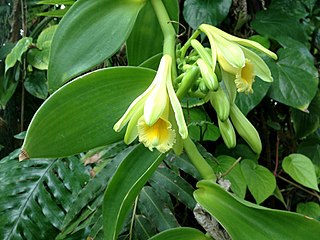
In botany, a fruit is the seed-bearing structure in flowering plants that is formed from the ovary after flowering.

Vanilla is a spice derived from orchids of the genus Vanilla, primarily obtained from pods of the flat-leaved vanilla (V. planifolia).

Dimocarpus longan, commonly known as the longan and dragon's eye, is a tropical tree species that produces edible fruit. It is one of the better-known tropical members of the soapberry family Sapindaceae, to which the lychee and rambutan also belong. The fruit of the longan is similar to that of the lychee, but less aromatic in taste. It is native to tropical Asia and China.

A nut is a fruit consisting of a hard or tough nutshell protecting a kernel which is usually edible. In general usage and in a culinary sense, a wide variety of dry seeds are called nuts, but in a botanical context "nut" implies that the shell does not open to release the seed (indehiscent).

A lime is a citrus fruit, which is typically round, green in color, 3–6 centimetres (1.2–2.4 in) in diameter, and contains acidic juice vesicles.

Mangosteen, also known as the purple mangosteen, is a tropical evergreen tree with edible fruit native to tropical lands surrounding the Indian Ocean. Its origin is uncertain due to widespread prehistoric cultivation. It grows mainly in Southeast Asia, southwest India and other tropical areas such as Colombia and Puerto Rico, where the tree has been introduced.

Citrus production encompasses the production of citrus fruit, which are the highest-value fruit crop in terms of international trade. There are two main markets for citrus fruit:

Vitex agnus-castus is a plant native of the Mediterranean region. It is one of the few temperate-zone species of Vitex, which is on the whole a genus of tropical and subtropical flowering plants. Theophrastus mentioned the shrub several times, as agnos (άγνος) in Enquiry into Plants. It has been long believed to be an anaphrodisiac – leading to its name as "chaste tree" – but its effectiveness for such action remains unproven.

Kidney disease, or renal disease, technically referred to as nephropathy, is damage to or disease of a kidney. Nephritis is an inflammatory kidney disease and has several types according to the location of the inflammation. Inflammation can be diagnosed by blood tests. Nephrosis is non-inflammatory kidney disease. Nephritis and nephrosis can give rise to nephritic syndrome and nephrotic syndrome respectively. Kidney disease usually causes a loss of kidney function to some degree and can result in kidney failure, the complete loss of kidney function. Kidney failure is known as the end-stage of kidney disease, where dialysis or a kidney transplant is the only treatment option.

Terminalia bellirica, known as baheda, bahera, behada, beleric or bastard myrobalan, Persian بلیله (Balileh), Sanskrit: Vibhītaka बिभीतक, Aksha अक्ष) is a large deciduous tree in the Combretaceae family. It is common on the plains and lower hills in South and Southeast Asia, where it is also grown as an avenue tree. The basionym is Myrobalanus bellirica Gaertn.. William Roxburgh transferred M. bellirica to Terminalia as "T. bellerica (Gaertn.) Roxb.". This spelling error is now widely used, causing confusion. The correct name is Terminalia bellirica (Gaertn.) Roxb.

The garden strawberry is a widely grown hybrid species of the genus Fragaria, collectively known as the strawberries, which are cultivated worldwide for their fruit. The fruit is widely appreciated for its characteristic aroma, bright red color, juicy texture, and sweetness. It is consumed in large quantities, either fresh or in such prepared foods as jam, juice, pies, ice cream, milkshakes, and chocolates. Artificial strawberry flavorings and aromas are also widely used in products such as candy, soap, lip gloss, perfume, and many others.

The mandarinquat, also misleadingly called orangequat, is any cross between a mandarin and a kumquat. Mandarinquats are members of the citrofortunella group.

Hexaconazole is a broad-spectrum systemic triazole fungicide used for the control of many fungi particularly ascomycetes and basidiomycetes. Major consumption is in Asian countries and it is used mainly for the control of rice sheath blight in China, India, Vietnam, and parts of East Asia. It is also used for control of diseases in various fruits and vegetables.
Mucor piriformis is a plant pathogen that causes a soft rot of several fruits known as Mucor rot. Infection of its host fruits, such as apples and pears, takes place post-harvest. The fungi can also infect citrus fruits.
Capnodium footii is a sooty mold that develops in coconut leaves.

Mangifera foetida is a species of plant in the family Anacardiaceae.

A walnut is the edible seed of any tree of the genus Juglans, particularly the Persian or English walnut, Juglans regia. They are accessory fruit because the outer covering of the fruit is technically an involucre and thus not morphologically part of the carpel; this means it cannot be a drupe but is instead a drupe-like nut.

Rajka is a hybrid cultivar of domesticated apple from the Czech Republic, specifically for eating. Rajka was crossed and developed by the Institute of Experimental Botany from the Champion and Katka apples for scab resistance, hence possible to grow organic.

'Akane', also known as 'Tokyo Rose', 'Tohoku No.3' and 'Prime Red', is a Japanese cultivar of domesticated apple, that according to Orange Pippin is one of the best early season apples.

'Dougherty' was a New Zealand cultivar of domesticated apple, which was grown mainly for export to the United Kingdom, from which a red coloured mutation is marketed today as 'Red Dougherty'. 'Dougherty' produces medium-sized fruits in late season, the skin background is greenish-yellow and flushed with some red. The flesh is yellowish with a sweet flavour.

















